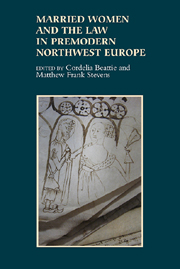Book contents
- Frontmatter
- Contents
- Figures and Tables
- Contributors
- Introduction: Uncovering Married Women
- 1 Inheritance, Property and Marriage in Medieval Norway
- 2 Spousal Disputes, the Marital Property System, and the Law in Later Medieval Sweden
- 3 When Two Worlds Collide: Marriage and the Law in Medieval Ireland
- 4 Married Women, Crime and the Courts in Late Medieval Wales
- 5 Peasant Women, Agency and Status in Mid-Thirteenth- to Late Fourteenth-Century England: Some Reconsiderations
- 6 London's Married Women, Debt Litigation and Coverture in the Court of Common Pleas
- 7 Married Women, Contracts and Coverture in Late Medieval England
- 8 Property, Family and Partnership: Married Women and Legal Capability in Late Medieval Ghent
- 9 ‘For His Interest’? Women, Debt and Coverture in Early Modern Scotland
- 10 The Worth of Married Women in the English Church Courts, c.1550–1730
- 11 Married Women, Work and the Law: Evidence from Early Modern Germany
- Index
2 - Spousal Disputes, the Marital Property System, and the Law in Later Medieval Sweden
Published online by Cambridge University Press: 05 July 2013
- Frontmatter
- Contents
- Figures and Tables
- Contributors
- Introduction: Uncovering Married Women
- 1 Inheritance, Property and Marriage in Medieval Norway
- 2 Spousal Disputes, the Marital Property System, and the Law in Later Medieval Sweden
- 3 When Two Worlds Collide: Marriage and the Law in Medieval Ireland
- 4 Married Women, Crime and the Courts in Late Medieval Wales
- 5 Peasant Women, Agency and Status in Mid-Thirteenth- to Late Fourteenth-Century England: Some Reconsiderations
- 6 London's Married Women, Debt Litigation and Coverture in the Court of Common Pleas
- 7 Married Women, Contracts and Coverture in Late Medieval England
- 8 Property, Family and Partnership: Married Women and Legal Capability in Late Medieval Ghent
- 9 ‘For His Interest’? Women, Debt and Coverture in Early Modern Scotland
- 10 The Worth of Married Women in the English Church Courts, c.1550–1730
- 11 Married Women, Work and the Law: Evidence from Early Modern Germany
- Index
Summary
Recent research has emphasized the nexus of separation customs and marital property systems in medieval Europe. Indeed, the practice of marital separation across the late-medieval Franco-Belgian region may have been influenced by its communal property system. Charles Donahue Jr has observed that ‘a system of marital community property, which existed all over the Franco-Belgian region, virtually requires that a separating couple obtain a public declaration that they have separated’, whereas the English ‘separate marital property system’ more markedly fostered informal ‘do-it-yourself’ separations. Donahue's observations have been corroborated by a recent article by Monique Vleeschouwers-Van Melkebeek, focusing on separation and the division of property in the late-medieval southern Low Countries. There, the ‘customary property system in the Franco-Belgian region spurred the couples on in their demand for a judicial separation’, in contrast to England. From the Franco-Belgian region, hundreds of preserved divisions of marital property can also be found in secular court records as a material consequence of judicial separations, granted by ecclesiastical courts.
- Type
- Chapter
- Information
- Married Women and the Law in Premodern Northwest Europe , pp. 31 - 52Publisher: Boydell & BrewerPrint publication year: 2013

